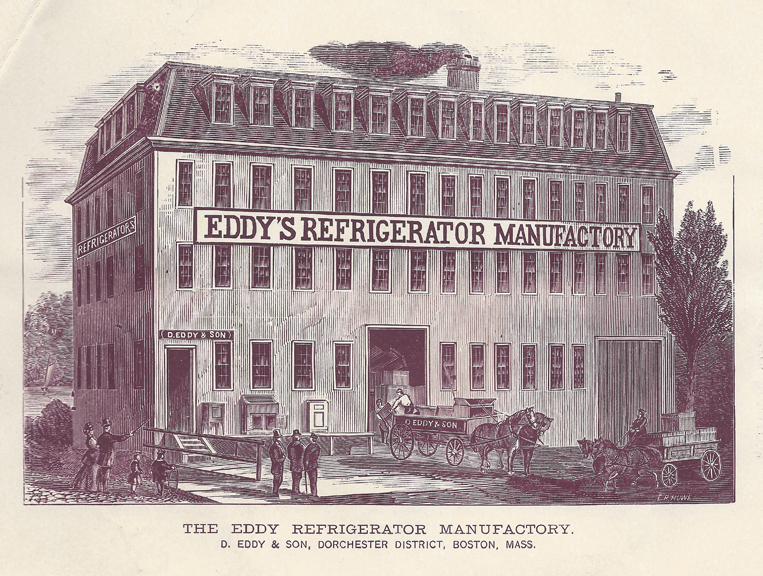No. 12261 Eddy Refrigerator (icebox) at the Dorchester Historical Society.
Darius Eddy founded the refrigerator company in 1847. After his death in the mid-1890s, the firm was in the hands of three of his sons: Darius, Lewis, Isaac H. and George. They took in their uncle J. Lodge Eddy, and by 1898 the firm is listed in the Boston Directory as D. Eddy & Sons (D.F., Lewis, Isaac H., George and J. Lodge), refrigerator manufacturers. 336 Adams Street, Dorchester. The facility was located at on Adams Street at the corner of Gibson.




The Eddy Refrigerator was a wooden chest with metal lining. There was a compartment to hold ice with a drain pipe for the melted water and another compartment for the storage of food.
Hover on the illustration below and use the arrows to read a copy of the Eddy Refrigerators Catalog for 1925.
PDF1198 Eddy Refrigerator Catalog 1925
In 1876 the Boston Daily Globe published a puff piece. “In the year 1847, Mr. D. Eddy, who is the oldest ice-chest manufacturer in this country, began the manufacture of ice-chests, as they were then called, n Boston, and in 1852 he removed to Dorchester, and since that time the manufacture under Mr. Eddy’s supervision has grown to mammoth proportions, and the improvements constantly added to the refrigerators … have made them the standard style throughout the United States, as well as in many foreign countries. … The best possible evidence for their freedom from moisture is found in the fact that matches can be kept in them for any length of time and ignite as readily as those kept in tin.”
The company manufactured many designs including a modest model that looked like a small freezer chest and very elaborate chests with separate compartments for wine storage.
On February 19, 1908, the Boston Daily Globe printed a report of a fire of suspicious origin at the plant. “The fire started about 6 o’clock and was discovered by Samuel D. Averill, a conductor on an Ashmont and Milton car, who, as he was passing along Dorchester av, saw smoke issuing from the warehouse on Gibson st, near the avenue. He rang in the alarm from box 993 at the Fields Corner car stables, and before the apparatus arrived the whole warehouse was a mass of flames. … During the last few months, there have been several mysterious fires on the premises of the company, and the firm has come to fear that it was harboring a firebug. The last previous fire, which has not been explained, was that about a month ago in the basement of the main factory on Adams st.” The next day the Globe reported that a fireman who answered the alarm had found a broken window, and the fire department suspected a firebug.
The company never embraced electricity, and their ice boxes were overshadowed by electric refrigerators that do not require the constant delivery of ice to the home.


